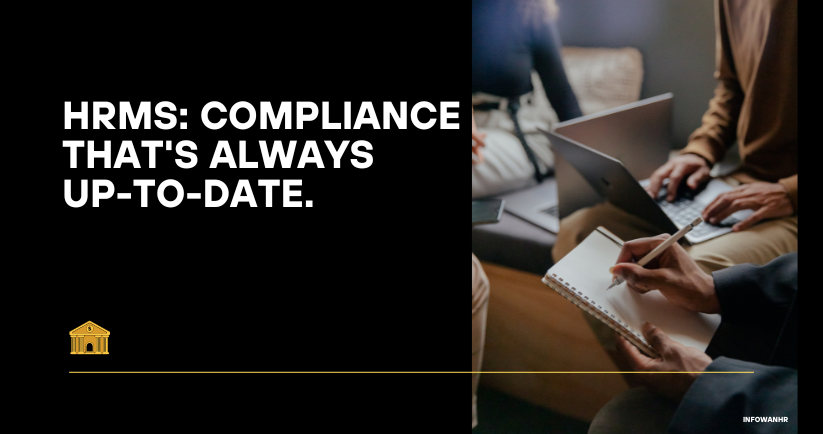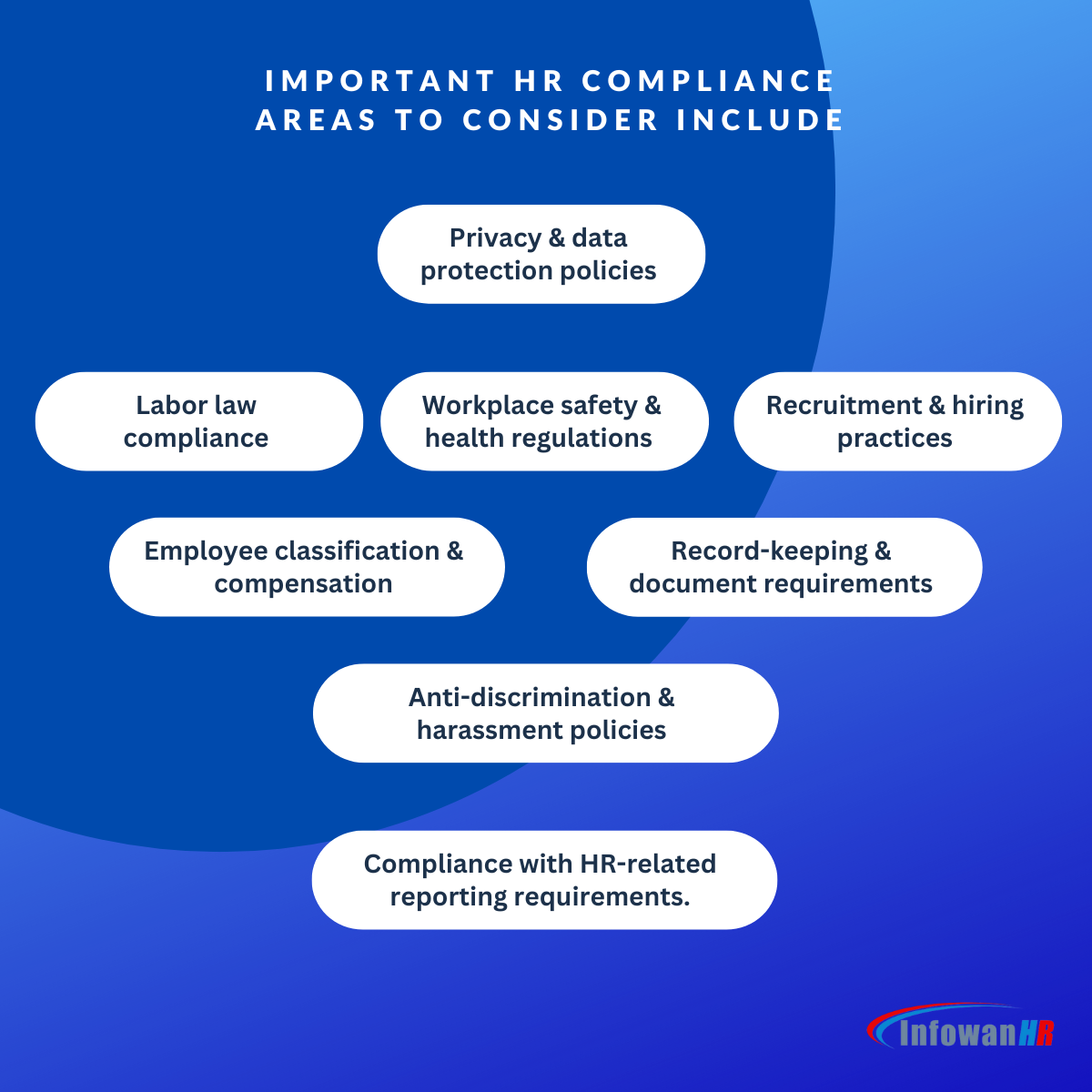
How can we help you today?
Registered Office
Infowan Technologies Pvt Ltd
Mumbai-401107. INDIA.
Contact Details
+91 98201 97205
+91 98201 26871
+91 98670 74415
support@infowan.net
info@infowan.net
|
Table of Contents
|
|---|
| How has HRMS software made HR compliance easier? |
| What is HR compliance? |
| Managing HR compliance without HRMS software |
| Managing Compliance and Other Regulations with HRMS |
| Various HR Compliance laws explained |
| Additional tips for ensuring HR compliance: |

HR compliance refers to the set of laws, regulations, and policies that organizations need to follow to ensure that their human resources practices are in line with legal requirements and ethical standards. This includes areas such as hiring, employee relations, compensation, benefits, training, and development. HR compliance helps to protect the rights of employees and employers while also ensuring that organizations operate in a fair and responsible manner. It is important for businesses to prioritize HR compliance to avoid legal and financial risks, as well as to maintain a positive reputation in their industry. By adhering to HR compliance, organizations can create a positive and productive work environment that supports the needs and rights of both employees and the company as a whole.
Managing HR compliance without HRMS softwareManaging HR compliance without the use of HRMS software involves a manual and resource-intensive approach. HR professionals in this scenario must stay well-informed about the complex web of HR laws and regulations relevant to their industry and location. They create detailed compliance calendars to track critical deadlines for tasks like tax filing, training renewals, and reporting obligations. Manual record-keeping becomes essential as accurate documentation of employee data, certifications, and benefits enrollment is maintained through spreadsheets or physical files. Regular internal audits are conducted to assess compliance status, identify areas for improvement, and address potential violations. Policies and procedures are documented and communicated to employees, and training sessions are provided to ensure staff understand their compliance responsibilities. Reporting involves manually collecting and compiling data from various sources for diverse purposes, such as diversity statistics and training completion rates. While this method can be effective, it demands careful organization, vigilance, and dedicated resources to prevent errors or omissions and ensure adherence to the ever-evolving landscape of HR regulations.
Managing Compliance and Other Regulations with HRMSAn HR management software can help with HR compliance in a company by automating and streamlining various HR processes such as employee data management, record keeping, and documentation. This can ensure that the company is meeting legal requirements and regulations related to HR compliance. The software can also provide alerts and reminders for important compliance tasks, such as training and certification renewals. Additionally, HR management software can help HR professionals stay up-to-date with changes in laws and regulations by providing access to relevant resources and information. Overall, using HR management software can help a company maintain compliance and reduce the risk of legal issues.
HR compliance includes various policies, practices, and procedures that ensure an organization is following all applicable laws and regulations related to employment. Some of the key areas that HR compliance covers are:

Ensuring HR compliance not only helps organizations avoid legal issues and penalties but also promotes a positive and ethical workplace culture that supports employee satisfaction and retention.
Payroll HR software can be a valuable tool for managing HR compliance. By automating tasks, providing real-time data, generating reports, and storing documents, HRMS software can help organizations to stay compliant with various regulations and avoid costly fines and penalties.
Various HR Compliance laws explained
►
Employment law
This includes laws that govern the hiring, firing, and compensation of employees. Some of the most
important employment laws include the Fair Labor Standards Act (FLSA), the Family and Medical Leave
Act (FMLA), and the Americans with Disabilities Act (ADA).
►
Taxation and payroll
This includes laws that govern the withholding and payment of taxes, as well as the calculation of
wages and deductions. Some of the most important taxation and payroll laws include the Internal
Revenue Code (IRC), the Social Security Act, and the Affordable Care Act (ACA).
►
Harassment and discrimination
This includes laws that protect employees from harassment and discrimination based on race, color, religion,
sex, national origin, age, disability, or other protected categories. Some of the most important
anti-discrimination laws include Title VII of the Civil Rights Act of 1964, the Age Discrimination
in Employment Act (ADEA), and the Americans with Disabilities Act (ADA).
►
Health and Safety
This includes laws that protect employees from workplace hazards. Some of the most important health and
safety laws include the Occupational Safety and Health Act (OSHA) and the Family and Medical Leave Act (FMLA).
►
Data privacy and security
This includes laws that protect the privacy and security of employee data. Some of the most important data
privacy and security laws include the General Data Protection Regulation (GDPR) and the California Consumer
Privacy Act (CCPA).
►
Labor unions
This includes laws that govern the formation and operation of labor unions. Some of the most important labor
union laws include the National Labor Relations Act (NLRA) and the Railway Labor Act (RLA).
These are just a few of the many topics that HR compliance covers. The specific laws and regulations that apply to an organization will vary depending on its size, industry, and location. It is important for all organizations to have a strong HR compliance program in place to protect themselves from legal liability and to create a safe and equitable workplace for their employees.
Here are some additional tips for ensuring HR compliance:With the above tips, organizations can help ensure that they are in compliance with all applicable laws and regulations.
These regulations are designed to ensure fair treatment of employees, protect their rights, and promote a safe and ethical work environment. Non-compliance can lead to legal liabilities, fines, lawsuits, and damage to the company's image. Therefore, HR professionals play a significant role in interpreting and implementing these regulations to create a fair and lawful work environment.